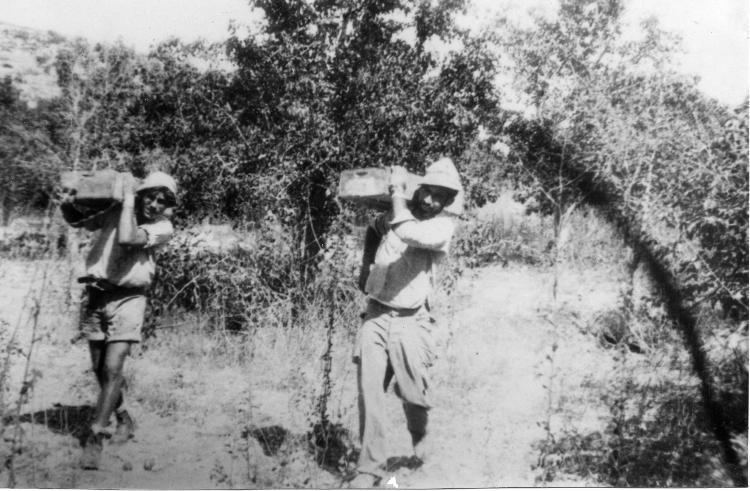Arabic علار Palestine grid 155/125 Local time Sunday 2:12 AM | Date of depopulation 22 October 1948 | |
 | ||
Weather 7°C, Wind E at 8 km/h, 46% Humidity | ||
Allar (Arabic: علار) or 'Allar el-Fawqa ("Upper Allar") was a Palestinian Arab village located southwest of the Old City of Jerusalem near Wadi Surar ("Valley of Pebbles"), along Wadi Tannur. The name was shared by the twin village of Allar al-Sifla ("Lower Allar") or Khirbat al-Tannur, with official imperial ledgers often listing them both under the single entry of Allar.
Contents
Habitation in the village spanned centuries and is attested in architectural remains and documents from the Crusader, Mamluk, Ottoman and Mandate Palestine periods. Allar was depopulated during the 1948 Palestine war and the Israeli moshavs of Matta and Bar Giora were established on its former lands.
History
The older of the two villages appears to have been Lower Allar. Remains of a Crusader-era church and cloister made up of five other vaulted buildings attest to habitation there in the 12th century. One of these buildings is thought to be a Cistercian house, a sister house of Belmont built in 1161, known as Saluatio.
From the 13th to 16th centuries, the villages were ruled by the Mamluk Sultanate based in Cairo and appear together in a document dating to circa 1264 that lists land grants made in Palestine by the sultan Baybars to his emir.s
Ottoman era
Toward the beginning of four centuries of rule over the area by the Ottoman Empire, in August 1553, two leaders of Allar were held accountable for the village failure to pay taxes and were arrested by the imperial authorities. The imperial defter of 1596 lists Allar as part of the nahiya ("subdistrict") of Jerusalem with 204 inhabitants who paid taxes on wheat, barley, olive trees, molasses, goats, and beehives.
The waqf custodian of the mosque in Allar (and that of Bayt Nuba) in 1810 was appointed by the Ottoman authorities, and hailed from the Jerusalem family of notables, the Dajanis. Also in the village was a shrine dedicated to al-Shaykh Ibrahim ("Abraham the Sheikh").
Western travellers who wrote of the village include Edward Robinson, who travelled throughout Palestine and Syria in 1838 and Victor Guérin, whose travels spanned many years in the latter half of the 19th century. Both describe Lower and Upper Allar as two distinct villages located in a valley. Robinson calls it er-Rumany wadi ("Pomegranate Valley"), while Guérin calls it Oued el-Limoun ("Valley of the Lemons/Limes"), so named because of the abundant presence of a variety of citrus tree there known to the Arabs as limoun. Both note the presence of a large, ancient, ruined church in Lower Allar. Robinson describes a fine fountain further up the valley that irrigated fruit trees and gardens below, noting the abundance of olive trees. Guérin describes A'llar es-Sifla ou et-Tahta as an oasis covered in grape vines, citrus, pomengranate and fig trees, irrigated by an ancient canal and a second inexhaustible water source. An Ottoman village list from about 1870 counted 56 houses and a population of 176, though the population count included men only.
The inhabitants of Upper Allar moved to Lower Allar at the end of the 19th century.
British Mandate era
While Upper Allar was repopulated during the period of British rule in Mandatory Palestine and housed a primary school, it is listed in British censuses from the time as a mazra'a ("farm").
In 1945, Allar had a population of 440 Muslims, and the total land area was 12,356 dunams. 353 dunums were irrigated or used for orchards, 2,234 dunams were for cereals, while 12 dunams were built-up (urban) Arab land.
1948, aftermath
During the 1948 Arab–Israeli War, Allar was depopulated as a result of a military assault by Israeli forces on 22 October 1948. It was one of a series of villages occupied during Operation Ha-Har, an offensive launched by Harel Brigade and Etzioni Brigade to widen the Jerusalem corridor.
The operation began on the night of 18–19 October with an attack on the Egyptian Army/Muslim Brotherhood forces stationed in the village to defend it alongside local militia. Great care was taken not to draw Transjordan's Arab Legion into the battle. The Egyptian army was forced to retreat to the west, and several villages southwest of Jerusalem were captured. A one-time resident of Allar during the hostilities of 1948 has said that the people of Allar, upon hearing the sound of gunfire from the direction of Dayr al-Hawa, were gripped with fear and trepidation. When they were told that some of the residents in Dayr al-Hawa had been killed, out of concern for their own safety, the villagers took flight, taking with them provisions and bedding material for their needs, and the last of that summer's harvest from their fields (wheat and lentils), fleeing by lorry to al-Khader, whence they found temporary shelter in caves around Bayt Jala, before eventually settling in Dheisheh Camp. Refugees who camped in the nearby gullies and caves were driven out in subsequent raids.
Refugees from Allar and other Palestinian villages who are old enough to remember life there express nostalgia for the natural abundance of the land lost. One Umm Jamal recalls eggplants, pomegranates, cucumbers and green beans as among the many products grown on the village lands which were fed by springs known to locals as Umm al-Hasan ("Mother of Goodness"), Umm al-Sa'd ("Mother of Happiness"), Umm Nuh ("Mother of Noah"), al-'Uyun ("The Eyes"), and Umm al-'Uyun ("Mother of the Eyes").
